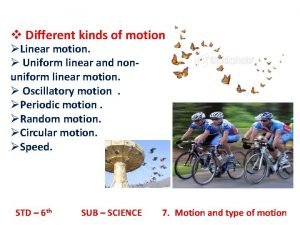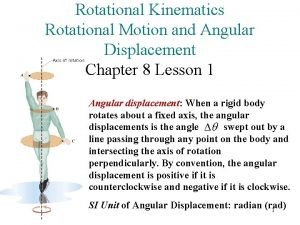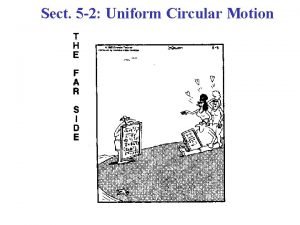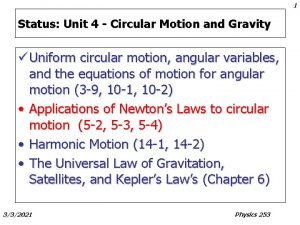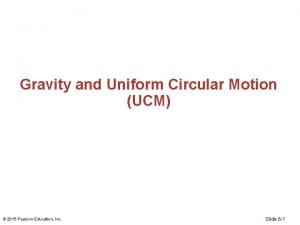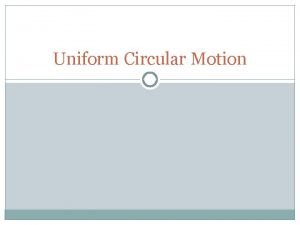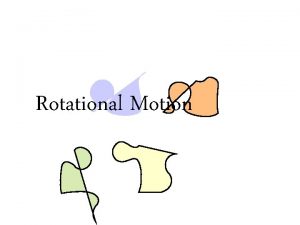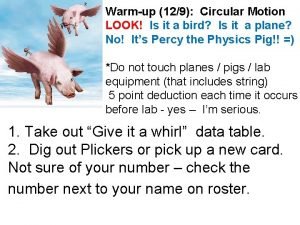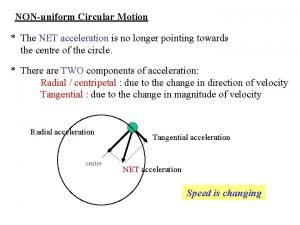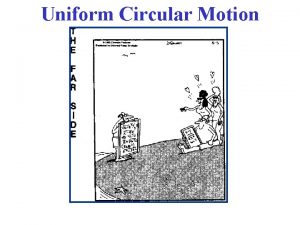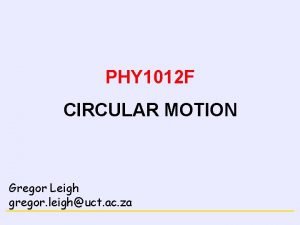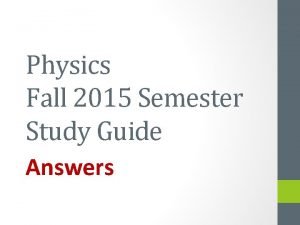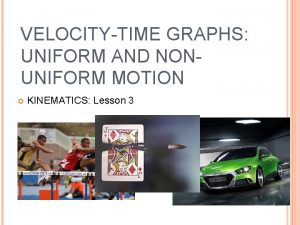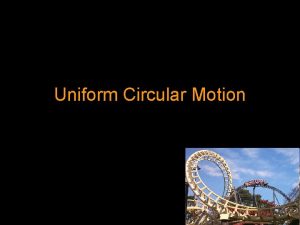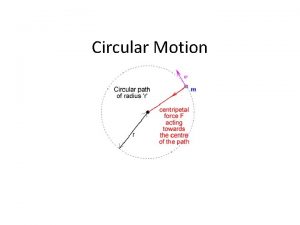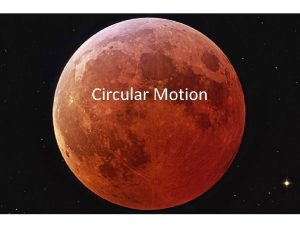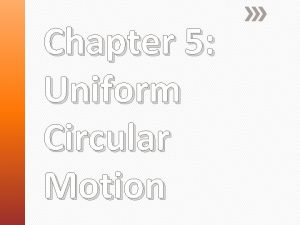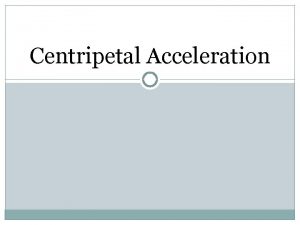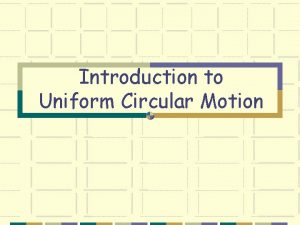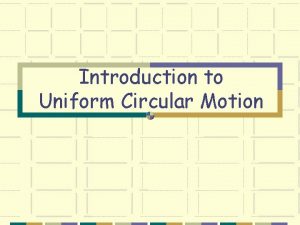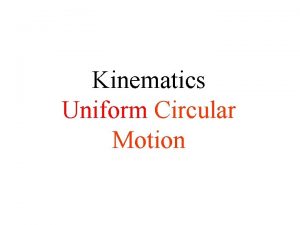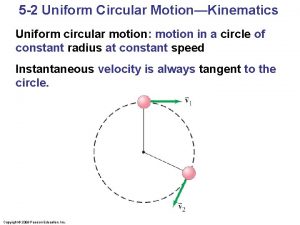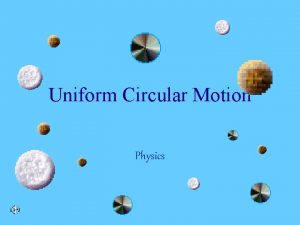Circular Motion Speed Uniform Circular Motion Motion of


















- Slides: 18

Circular Motion

Speed Uniform Circular Motion: Motion of an object in a circle with constant/uniform speed. • Average speed= distance/time=circumference/time – Circumference= 2πr • Therefore average speed= 2πr/T – T= time required to make one cycle around the circumference (period) Plicker Question: How are radius and average speed related?

Velocity Plicker Question: Do objects moving with uniform circular motion have constant velocity? • Remember vectors have magnitude and direction • Magnitude remains constant • Direction changes – The direction of the velocity vector at an instant is in the direction tangent to the circle

Practice Circumference = 2 • PI • R Use your average speed equation to determine the speed of a rider on a carousel ride that makes a complete revolution around the circle (diameter = 21. 2 - meter) in 17. 3 seconds.

Practice Circumference = 2 • PI • R Use your average speed equation to determine the speed of your clothes that are plastered to the wall of the washing machine during the spin cycle. The clothes make a complete revolution around a 61. 9 -cm diameter circle in 0. 285 seconds.

Acceleration Plicker Question: Is an object moving in uniform circular motion accelerating? • Remember acceleration occurs when an object changes its velocity. • Therefore objects moving in a circle at a constant speed are accelerating!

Acceleration Continued Acceleration = Δv/t = vf-vi/t • Notice that the direction of the acceleration vector points towards the center. • Objects moving in circles at a constant speed accelerate towards the center of the circle.

Practice An object moves in a clockwise direction along the circular path as shown in the diagram at the right. Three points along the path are labeled - A, B and C. For each location, draw a straight-line vector arrow in the direction of the velocity vector; label this vector as v. Then draw a straight-line vector arrow in the direction of the acceleration vector; label this vector as a.

Centripital Force • Remember: – An object experiencing acceleration also experiences a net force – The net force is in the same direction as the acceleration • Centripetal force is used to describe the inward force acting upon and object to cause inward acceleration • Centripetal ~ “center-seeking”

Centripital Force Inertia • Newton’s First Law: An object in motion stays in motion unless acted upon by an unbalanced force. • Consider these three scenarios – A car accelerates from a stopped position – A car comes to an abrupt stop – A car takes a sharp left turn – What is happening to the passenger in these scenarios?

Examples: • As a car turns the force of friction acting upon the turned wheels of the car provide centripetal force required for circular motion. • As the banana orbits the Earth, the force of gravity acting upon the moon provides the centripetal force required for circular motion.

Centripetal Force and Direction Change • Centripetal force alters the direction of the object without altering the magnitude. Why? • Think about work: W=F d cosΘ • Force acts perpendicular to the direction of the objects movement, therefore W=0, TME is conserved, and kinetic energy remains constant

Centripetal Force and Direction Change • Centripetal force alters the direction of the object without altering the magnitude. Why? • In the diagrams does the force impact velocity? • Newton’s second law: Fnet = m a • Forces can only impact an object when they are direct in the same or opposite direction of the object’s motion.

The Forbidden F-Word • Centrifugal: away from the center (outward) • Does the sensation of being thrown outward from the center of a circle mean that there was definitely an outward force? • If there is such an outward force on my body as I make a left-hand turn in a car, then what physical object is supplying the outward push/pull? • Could this sensation be explained in other ways that are more consistent with Newton’s laws? • Let’s refrain from using the F-Word.

Practice Noah Formula guides a golf ball around the outside rim of the green at the Hole-In-One Putt-Putt Golf Course. When the ball leaves the rim, which path (1, 2, or 3) will the golf ball follow?

Plicker Question! Suppose that you are a driver or passenger in a car and you travel over the top of a small hill in the road at a high speed. As you reach the crest of the hill, you feel your body still moving upward; your gluts might even be pulled off the car seat. It might even feel like there is an upward push on your body. This upward sensation is best explained by the ______. a. tendency of your body to follow its original upward path b. presence of an upward force on your body c. presence of a centripetal force on your body d. presence of a centrifugal force on your body

Plicker Question! Darron Moore is on a barrel ride at an amusement park. He enters the barrel and stands on a platform next to the wall. The ride operator flips a switch and the barrel begins spinning at a high rate. Then the operator flips another switch and the platform drops out from under the feet of the riders. Darron is plastered to the wall of the barrel. This sticking to the wall phenomenon is explained by the fact that ____. a. the ride exerts an outward force on Darron which pushes him outward against the wall b. Darron has a natural tendency to move tangent to the circle but the wall pushes him inward c. air pressure is reduced by the barrel's motion that causes a suction action toward the wall d. the ride operator coats the wall with cotton candy that causes riders to stick to it

Reflection Time In this unit, you will be investigating a commonly held misconception about the world - that motion in a circle is caused by an outward (centrifugal) force. This misconception or wrong belief is not likely to be dispelled unless you devote some time to reflect on whether you believe it and whether it is intelligible. After considering more reasonable beliefs, you will be more likely to dispel the belief in a centrifugal force in favor of a belief in an inward or centripetal force.
 Type of motion
Type of motion Angular velocity units
Angular velocity units Constant speed in circular motion
Constant speed in circular motion Non uniform circular motion
Non uniform circular motion A physics textbook swings back and forth as a pendulum
A physics textbook swings back and forth as a pendulum Circular motion lab
Circular motion lab Centripetal motion equations
Centripetal motion equations Dynamics of uniform circular motion
Dynamics of uniform circular motion Formula for centripetal acceleration in circular motion
Formula for centripetal acceleration in circular motion Non uniform circular motion
Non uniform circular motion How are uniform circular motion maps
How are uniform circular motion maps What is uniform circular motion
What is uniform circular motion Rtz coordinate system
Rtz coordinate system Minimum velocity
Minimum velocity How do you classify uniform and non-uniform mixtures?
How do you classify uniform and non-uniform mixtures? Pure substance examples
Pure substance examples Aliran seragam dan tidak seragam
Aliran seragam dan tidak seragam -2(d+17)=64
-2(d+17)=64 Uniform speed graph
Uniform speed graph
